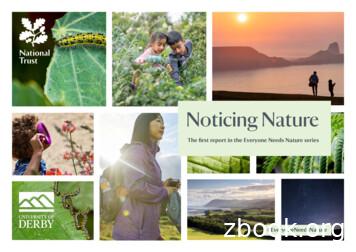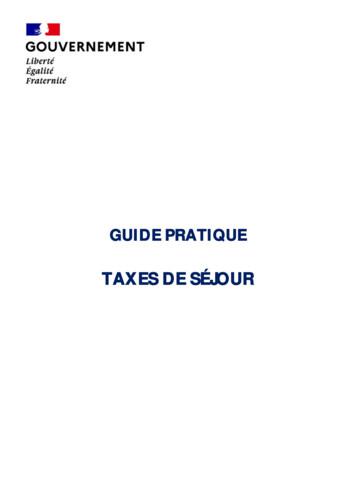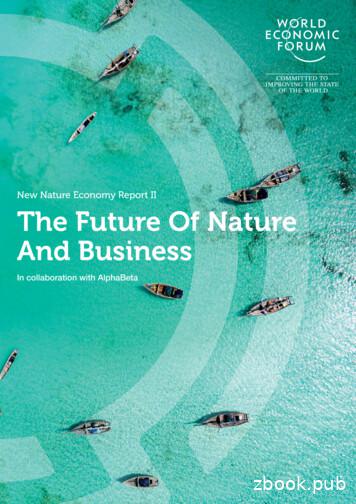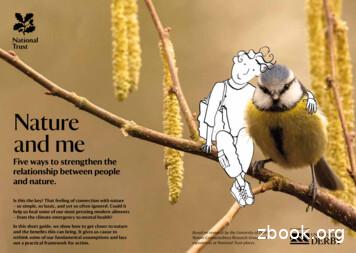Noticing Nature - Fastly
Noticing NatureThe first report in the Everyone Needs Nature series#EveryoneNeedsNature
IntroductionNoticing Nature2
About this researchThis report:A growing body of evidence points to the positive impactsof nature for people. Yet, while evidence is growing rapidly,this is prompting new questions about the essentialingredients of a positive and sustainable relationshipwith nature for individuals. provides an overview of our main findings, includingdeeper analysis by University of Derby of data fromwide-ranging national surveys we undertook withchildren and adults. Fieldwork for these surveys wasconducted on our behalf by YouGov;Working in partnership with Professor Miles Richardsonand his team of researchers at University of Derby’s NatureConnectedness Research Group, we therefore designed aprogramme of research with both children and adults, toenrich understanding of: shares further insight from a qualitative studyconducted for us by ResearchBods, which builds onrecent research by Professor Richardson and his team. the different factors that are associated with childrenand adults proactively doing things to help nature andwildlife, making use of newly established measures of‘pro-nature conservation’ behaviours; the significance of people’s participation in simple,everyday acts of ‘tuning in’, noticing or paying attentionto nature, relative to other previously explored factorssuch as time spent outdoors; how these and other aspects in people’s relationshipwith nature are associated with higher or lower levelsof wellbeing; and the personal benefits that people report from beingprompted to ‘take notice’ or do things to help natureon a daily basis.Noticing Nature3
Why do some people take action to helpnature? And why do others not?For many people, nature is not an integralpart of their lifeFor a long time, this has been talked about in terms ofeducation. You need to teach children biology so theycan appreciate the natural world. It’s a question ofscientific understanding.This report reveals that just 19% of children regularly noticewildlife. In the past year 57% of adults rarely or neverwatched the sunrise. Only 27% frequently watched clouds.Others have argued that it’s about spending time in thegreat outdoors. Explore the Amazon. Climb a mountain.Get out there and see the world.But what if it’s simpler than that?What if the little things make thebiggest difference?Listening to birdsong. Looking at the stars. These arethings humans have been doing since the dawn of time.What if the biggest blocker between us and saving theplanet (and ourselves) is the fact that we’ve stoppednoticing nature?Yet these activities are free. They make us feel good.And they can be done close to home.According to our research, such moments are adefining factor when it comes to taking pro-natureconservation action.Noticing nature in small, everyday wayscould lead to radical resultsWe’ve found that ‘noticing nature’ and ‘natureconnectedness’ are strongly linked to people takingconservation action.The influence of these factors is far greater than theinfluence of ‘time spent outdoors’ or ‘knowledge andstudy of nature’.People taking conservation action are more likely to be‘noticing nature’ than they are to be studying it. They’re notnecessarily going on big outdoor adventures, but they areenjoying simple moments with the natural world.Noticing Nature4
Connecting with nature on a regularbasis enhances wellbeingThis year marks the National Trust’s125th anniversaryThis report also uncovers a powerful link between natureand both happiness and feeling life is worthwhile. Inaddition to having control over their life, we foundthat ‘nature connectedness’ and ‘noticing nature’had a significant impact on people’s wellbeing.The National Trust was established in 1895 because ourfounders believed in the importance of making nature,beauty and history available to ordinary people.In many ways, this is a hopeful reportThe public are concerned about natureand they want institutions to actIt’s clear that there’s more we can do as individuals.But it’s possible that the first step on that journey istuning into the world around us.We need to connect with nature on a daily basis. We needto notice birds, stars and wild flowers. It’s a radical, butstraightforward proposition. And, in many ways, it’s nota new one.Noticing NatureAs part of the anniversary celebrations, we’ve announcedthree new ambitions: We’ll be carbon neutral by 2030 We’ll plant 20 million trees in 10 years We’ll create green corridors for people and natureWe will also encourage people to connect withnature in simple ways. You can read more about ourNoticing Nature action plan at the end of this report.5
‘We all want quiet. We all want beauty. We all need space. Unless we have it,we cannot reach that sense of quiet inwhich whispers of better things cometo us gently.’Octavia Hill, 1883Co-founder of the National TrustNoticing Nature6
Contentsand researchheadlines
Contents andresearchheadlinesIntroductionPage 2How this report was createdPage 11FindingsPage 14Concern for naturePage 15 A dults and children are concerned aboutthe state of the UK’s nature M ore than half of adults have noticed adecline in wildlife in their lifetimeLooking to our futurePage 18 People are pessimistic about the future of nature They believe strong protections are neededOrganisational and government actionPage 22 P eople believe UK politicians andbusinesses could do more to help natureFactors linked to individuals taking actionPage 25 ‘ Nature connectedness’ and ‘noticing nature’ areimportant factors in people taking conservation action They are stronger predictors of action than ‘time spent outdoors’Noticing Nature8
Contents andresearchheadlinesFactors linked to wellbeingPage 32 ‘ Nature connectedness’ and ‘noticing nature’ are stronglyassociated with happiness and the feeling that life is worthwhile I n addition to having control over their life, we foundthat ‘nature connectedness’ and ‘noticing nature’ hada significant impact on people’s wellbeingFactors linked to physical and mental healthPage 37 O n average, the most nature-connected adults haveself-reported health scores that are 9% higher thanthe rest of the population ‘ Nature connectedness’ is associated withlower levels of depression and anxietyThe Noticing Nature challengePage 39 P articipants completed one ‘noticing nature’ activityevery day for a week A fter completing this challenge, participants felt freer,more mindful, closer to loved ones and they experiencedhigher levels of self-esteemHow often people ‘notice nature’Page 45 Although simple engagements with nature are stronglylinked to conservation action and personal wellbeing,they are infrequent parts of most people’s livesNoticing Nature9
Contents andresearchheadlinesNoticing Nature action planPage 48 Promote everyday access to simple moments in nature Establish a UK-wide measure and target for ‘nature connectedness’ Encourage action across society, from politicians to individual citizensAppendixContext of our researchPage 53 E xplains the need to better understand the factors drivingconservation action and the links between nature and wellbeingNoticing NatureAcknowledgementsPage 57Notes and referencesPage 5910
How thisreport wascreatedNoticing Nature11
National surveyThe Noticing Nature challengeWe surveyed nationally representative samples of 2,096adults aged 16 (in England, Wales and Northern Ireland)and 1,051 children (in Great Britain) aged between 8 and 15.We recruited 283 adults to The Noticing Nature challenge.This included a mix of the general population, NationalTrust members and National Trust volunteers.This is the first population-wide survey of its kind to focuson pro-nature conservation action, such as providing foodfor wildlife – rather than pro-nature environmental action,such as cutting back on air travel.Participants were given a programme of simple ‘noticingnature’ activities. The activities were informed by theUniversity of Derby’s work on noticing the good thingsin nature.The survey explores attitudes to nature, participation innature activities, participation in pro-nature conservationaction and self-reported wellbeing. It looks at relationshipsbetween these factors and ‘nature connectedness’.‘Nature connectedness’ is an internationally acceptedpsychological construct that describes the closeness ofan individual’s relationship with nature.We measured the impact these activities had onindividuals, using an online tool where participants kepta diary. This research was undertaken by ResearchBods,a specialist in research with online communities.The survey design and data analysis were undertakenby the National Trust’s audience research team incollaboration with the University of Derby NatureConnectedness Research Group. The survey was conductedby YouGov.The children’s survey took place on 19–24 July 2019.The adults’ survey took place on 29–30 July 2019.Noticing NatureExisting evidenceOur research builds upon existing evidence aboutpeople’s relationship with the natural world.Please see the appendix for further information.
Defining ‘nature connectedness’We measured ‘nature connectedness’ with a questionbased on Wesley Shultz’s Inclusion of Nature in Self Scale.We used the same question for adults and children:Q. Please select the picture belowwhich BEST describes your relationshipwith nature.The first picture shows you and nature being far awayfrom each other and the last picture shows you and naturebeing close to each other. Imagining one of the circles isyou and the other is nature, how interconnected are youwith nature right tureSelfNatureNoticing Nature13
FindingsNoticing Nature14
Concern for natureThere are very high levels of concernabout the state of natureAround three quarters (73%) of children and four out offive adults (81%) say they are concerned about a decline inwildlife in the UK. (Figure 3)Our research also indicates that levelsof concern could be growingMore than half of children (55%) and just under half ofadults (49%) say they are more concerned about natureand wildlife than they were a year ago. (Figure 4)Amongst adults, we find that increased concern is highestamong younger age groups, with 56% of those aged 16–24agreeing that they are more concerned than they were ayear ago.Many adults have noticed a declinein wildlifeJust over half of adults (52%) agree that they ‘havepersonally noticed a reduction in UK wildlife in theirlifetime’. This is highest amongst those aged 55 .60% of this group agree that they have personallyseen a reduction in their lifetime.Noticing Nature15
Figure 3Variations in concern for decline in wildlife mongst adults, concern about the decline in wildlifeAbecomes more prevalent with age. Seven in 10 (70%) of16–24 year olds are concerned compared with nearly9 in 10 (88%) of those aged 55 . aving access to green space over which you haveHsome ‘ownership’ is linked to higher concern. Adults orchildren, with access to their own garden or other greenspace they help care for, are more likely to be concernedabout the decline in nature than those without access. oncern varies by the type of area people live in.CAdults and children living in rural areas are more likelyto be concerned than those living in urban areas.% children and adults concerned –by green space access/area they live inQ. Adults: How concerned or unconcernedare you about the decline in wildlife in the UK(such as birds, animals, insects)? – Net concernedQ. Children: How much do you agree or disagree with thissentence? I am concerned about the decline in wildlife(such as birds, animals, insects). Net agree86%76%82% 83%85%82%73%% of people concerned – by age83%80%89%78%84%71%60%Q. How much do you agree or disagree with this sentence?I am concerned about the decline in wildlife (such as birds,animals, insects). Net concernedChildren73%84%Adults70%88%81%75%Garden athomeChildrenChildrenNoticing Nature16–2425–3940–5455 AllAllotmentI help lookafterCommunitygarden I helplook afterNone oftheseUrbanTown andFringeRuralAdultsUnweighted base: All GB children 8-15 (1051); All UK adults 16 (2096). Source: YouGov for National Trust16
Figure 4Increased concern about nature andwildlife compared to a year ago e see the greatest signs of a growing concernWabout nature and wildlife amongst children andyounger adults; 55% of children and 56% of adultsaged 16–24 say they are more concerned than a yearago, compared to 43% of those aged 55 .56%55%53%49%49%43% dults living in Rural (60%) or Town & Fringe (59%)Aareas are also more likely to say that they are moreconcerned about nature and wildlife than a year agothan those living in Urban areas (53%). For childrenit is those in Rural areas that are most likely to havebecome more concerned than a year ago, comparedto those in Urban or Town and Fringe areas.16-24All25-3940-5455 60%59%49%54%53%45%% who are more concerned thana year ago – by age and type ofarea they live inQ. Do you agree with the statement ‘I ammore concerned about nature and wildlifethan I was a year ago’? Net agreementUrbanChildrenTown and FringeRuralAdultsUnweighted base: All GB children 8-15 (1051); All UK adults 16 (2096). Source: YouGov for National TrustNoticing Nature17
Lookingto ourfuture18
Looking to our futureThere’s widespread pessimism aboutthe future of the UK’s natureAlmost 7 in 10 (67%) adults believe the natural environmentwill be in a worse state in 20 years. (Figure 5)iiiBy comparison, only 1 in 10 (11%) see any prospect forimprovement. Only 2% believe that the natural environmentwill be ‘much better’ in 20 years. A further 9% believe itwill be ‘slightly better’.There’s a strong desire to protectnature and scepticism about politicians’motivationsAlmost everyone agrees that it’s important that nature hasstrong protections. (Figure 6)86% agree that ‘it’s important that there are strong lawsto protect nature in the UK’. Meanwhile, 75% agree that‘I would be very concerned if Brexit reduced protection fornature in the UK’.Our survey found several potentialreasons for this pessimismA large majority of people acknowledge that ‘the balanceof nature is very delicate and easy to upset’ and feel that‘humans are severely abusing the planet’. (Figure 6)Most adults disagreed with the statement that ‘humanshave the right to modify the natural environment to suittheir needs’.Noticing Nature19
Figure 5Pessimism for the future ofthe natural environment lmost 4 in 10 are extremely pessimistic, saying thatAin 20 years’ time nature and the natural environmentwill be ‘much worse’ for today’s generation of children.Only 2 in 100 think it will be ‘much better’ in 20years’ time. T he youngest adults in our sample are even morepessimistic with 45% of 16 to 24 year olds saying itwill be ‘much worse’. Q. Thinking about today’s generationof children (that is those up to 15 yearsold) as adults in 20 years’ time .in comparison to how it is today,how much better or worse do you thinknature and the natural environmentwill be in the UK, or will it be aboutthe same?8% e also saw regional differences with nearly half (48%)Wof those living in the North East saying it will be ‘muchworse’ while only 32% of those in London, Yorkshireand the Humber and Northern Ireland saying this.2%9%37%14%30%Unweighted base: All UK adults 16 (2096). Source: YouGov for National Trust – Nature Survey (Adults aged 16 )Noticing NatureMuch betterSlightly betterAbout the sameMuch worseSlightly worseDon’t know20
Figure 6Nature values and attitudes78% agree that ‘thebalance of nature is verydelicate and easily upset’85% agree that ‘humansare severely abusingthe planet’53% disagree that ‘humanshave the right to modifythe natural environmentto suit their needs’, withonly 18% agreeing75% agree that ‘I would bevery concerned if Brexitreduced protection fornature in the UK’Only 19% agree that‘ensuring people havejobs in the UK today ismore important thanprotecting nature andwildlife for the future’.41% disagree with thisstatement86% agree that ‘it’simportant that there arestrong laws to protectnature in the UK’Unweighted base: All UK adults 16 (2096). Source: YouGov for National Trust – Nature Survey (Adults aged 16 )Noticing Nature21
Organisationaland governmentaction
Few adults believe that organisationsor influencers are doing enough toprotect natureThe majority feel that politicians, house builders,construction companies and the big supermarkets‘could do more’. (Figure 7)Children have similarly high expectationsHalf of children (50%) say that their parents or guardians‘could do more’. (Figure 7) Six in 10 (61%) say that theirschool ‘could do more’. Four out of five (81%) agree thatadults in general ‘could do more’.The same applies to energy companies, big technologycompanies (such as Apple and Google), local councils,local Members of Parliment (MPs), water companiesand farmers.There’s no room for complacency amongst organisationsdirectly working to help nature. Around one in three peoplebelieve that conservation organisations and environmentalcampaign groups ‘could do more’.Noticing Nature23
Figure 7:Doing enough to help andprotect nature in the UKFew adults think many organisations or individualswith influence are doing enough to protect nature.Around 4 in 5 people feel politicians in general,house builders, the big supermarkets, energycompanies and big technology companies ‘coulddo more’. Expectations for ‘doing more’ aren’tfar behind for local councils, local MPs and watercompanies. More than half (54%) also think farmers‘could do more’, and a smaller but significantproportion of people believe that conservationorganisations (38%) and environmental campaigngroups (36%) ‘could do more’.Amongst children around 8 in 10 think that adultscould be doing more, 6 in 10 that their schoolcould be doing more, and 1/2 that their parent(s)or guardian(s) could be doing more.Adults in general81%9%10%28%11%39%10%My schoolChildren61%My parent(s) My guardian(s)50%Politicians (excluding local MPs)84%5%11%House building and construction companiesAdults83%5%12%The big supermarkets (such as Asda, Sainsburys, Tesco)6%81%13%Energy companies (for example EDF, British Gas)80%5%15%9%13%Your local council78%Technology companies (for example Apple, Google)5%78%17%Water companies (such as Thames Water, Scottish Water)9%76%Q. In general, do you think each ofthe following could do more to helpand protect nature in the UK, or doyou think they are doing enough?16%Your local MP8%74%18%Farmers54%30%15%47%14%Conservation organisations (such as National Trust, RSPB)38%Environmental campaign groups (for example Greenpeace, Friends of the Earth)46%36%Unweighted base: All GB children 8-15 (1051); All UK adults 16 (2096)Source: YouGov for National TrustNoticing NatureThey coulddo moreThey are doingenough18%Don’tknow24
Factorslinked toindividualstaking action
The conservation actions examinedin our survey included:Amongst children: aking homes for nature (such as insects,Mhedgehogs) rowing flowers and/or plants thatGbirds and insects will like Putting food out to feed garden birds Leaving an area of lawn/flowerbed to grow wild oting for parties or laws that are conservation,Vnature or wildlife friendly etting in touch with Local Authorities aboutGnature conservation issuesAnd amongst adults with access to a garden, allotmentor community garden that they helped look after: lanting pollinator friendly plantsP(ones that are good for bees or other insects) dding log piles or other materials that can be used asAhome/shelter for wildlife T aking part in a wildlife survey(such as Garden Bird Watch, BioBlitz) aintaining plants with fruits or berriesM(for example, by not trimming them) T alking to other people (such as family and friends)about the importance of looking after nature andthe environment Providing food for wild animals (such as birds, squirrels) Picking up litter to help nature have a better home voiding disturbing wildlife when walking inAnature by myself or with a dogAmongst adults Making homes for wildlife Putting out food or water for wildlife Doing unpaid voluntary work outdoors Picking up litter when they see itNoticing NatureVery few activities are regularlydone by the majority of peopleFor children there is only one activity in which more thanhalf of children (55%) participated with any great frequency– ‘avoiding disturbing wildlife’. (Figure 8)Likewise, there is only one activity – ‘putting food or waterout for wildlife’ – that more than half of adults (55%) dowith great frequency. (Figure 9)26
Figure 8Pro-nature conservationbehaviours in childrenWe find variations in participation amongst children based on geographyfor some behaviours. For example, children living in Town and Fringelocations were the most likely to say they had ‘often or sometimes put foodor water out for wildlife’ (62%). In comparison, children living in Urban orRural areas were less likely to have done this (53% and 55% respectively).This translated into regional and national differences, with childrenin London less likely to have ‘often’ or ‘sometimes’ done this (49%)compared to children in Wales (64%) or Scotland (63%).Q. How often, if at all, do you do thefollowing? How often have you doneeach of the following in the past year?Always, very frequentlyor frequentlyA similar pattern was seen in other activities by type of area they live in.Children in Urban areas were less likely to have ‘always’, ‘very frequently’ or‘frequently’ picked up litter to help nature have a better home’in comparison to Rural children (32% vs 41%).Rarelyor neverSometimes oroccasionallyTake part in wildlife surveys (such asGarden Bird Watch, Bioblitz)9%I don’t know23%63%Pick up litter to help nature have a better home33%41%Talk to other people (such as family, friends)about the importance of looking after natureand the environment33%40%When walking in nature, by myself or with a dog,I try to avoid disturbing wildlife55%OftenSometimesMade a home for wildlifePut out food or water for wildlifeRarelyor never6%24%22%26%9%2%4%11%I don’t know/can’t remember6%27%19%62%36%4%43%3%Unweighted base: All UK adults 16 (2096). Source: YouGov for National Trust – Nature Survey (Adults aged 16 )Unweighted base: All GB children aged 8 to 15 (1051). Source: YouGov for National Trust – Children & Nature SurveyNoticing Nature27
Figure 9Pro-naturebehavioursin adultsQ. How often have you done each of thefollowing things in the past year?Doing unpaid, voluntary work outdoors12%Made a home for wildlife29%Put out food or water for wildlife55%Q. How often, if at all, do you do each ofthe following in your garden/allotmentby yourself or with someone else?Don’t know/can’t recallNET: Neveror rarelyNET: Often orsometimes3%85%3%67%3%42%NET: Rarely,neverNET: Always, veryfrequently, frequentlyDon’t knowNET: Sometimes,occassionallyA. Pro-nature: actions in the gardenPlant pollinator friendly plants(ones that are good for bees and other insects)45%Add log piles or other materials that can be used asa home/shelter by wildlife21%Maintain plants with berries/fruits(for example, by not trimming them)39%Provide food for wild animals(such as birds, squirrels)47%3%28%24%2%55%22%24%2%35%21%1%31%Q. How often, if at all, do you do each ofthe following?B. Pro-nature: citizenshipI get in touch with local authorities on natureconservation issues5%I vote for parties/candidates with strongpro-nature conservation policies in elections26%17%5%74%29%30%15%Base: A. All UK adults 16 (2096) with a garden, allotment or community garden (1,692). B: All UK adults aged 16 (2096)Source: YouGov for National Trust – Nature Survey (Adults aged 16 )Noticing Nature28
We explored how the following factorshelped explain the variation in people’sconservation actions: Demographics Nature connectedness (as defined on page 56) Time spent outdoors How likely they are to engage with nature throughsimple activities Indirect engagement with nature (for examplewatching or listening to nature programmes on radio orTV) Knowledge and study of nature Valuing and concern for nature Pro-nature environmental action (that is, actions linkedto global, environmental concerns – rather than local,conservation concerns)Some of these factors worked to explain 70% of thevariation in people’s pro-nature conservation behaviours.Noticing Nature‘Noticing nature’ has the greatestinfluence on conservation action.We found that simple forms of engagement – everydayacts of paying attention to nature – were the most closelylinked to conservation action.In particular, we identified seven significant ‘noticingnature’ behaviours: Watching wildlife (for example bird watching) Listening to birdsong Smelling wild flowers aking a photo/drawing or painting a picture Tof a natural views, plant, flower or animal Taking time to notice butterflies and/or bees Watching the sunrise Watching clouds‘Nature connectedness’ was also a key factor inconservation action.Reading and talking about nature, environmentalbehaviours, levels of concern, and knowledge ofnature also helped explain conservation behaviours.29
Spending time outdoors doesn’tnecessarily drive conservation action.Surprisingly, ‘time spent outdoors’ does not appear tosignificantly increase the likelihood of an individual takingconservation action.It’s what you do with your time that makes thecritical difference – rather than how much timeyou spend outdoors.People who ‘notice nature’ are much more likely to dothings to help nature.People who ‘always’ or ‘often’ do the seven ‘noticingnature’ activities are much more likely to take conservationaction than those who ‘rarely’ or ‘never’ do these activities.(Figure 10)Noticing Nature30
Figure 10High and low ‘noticing nature’groups and actions to help natureHigh ‘noticing nature’group (always or oftendo the seven ‘noticingnature’ activties (A))AdultsLow ‘noticing nature’group (rarely or neverdo the seven ‘noticingnature’ activties (B))High ‘noticing nature’group (always or oftendo the seven ‘noticingnature’ activties (A))79%% who always, very frequentlyor frequently plant pollinatorfriendly plants (ones that aregood for bees and other insects)74%% who always, very frequentlyor frequently maintainplants with berries/fruits(for example, by not trimming them)6%78%74%% who often or sometimesmake a home for wildlife1%71%3%ChildrenLow ‘noticing nature’group (rarely or neverdo the seven ‘noticingnature’ activties (B))69%% who always, very frequentlyor frequently pick up litter tohelp nature have a better home7%% who always, very frequentlyor frequently when walking innature, by myself or with a dogtry to avoid disturbing wildlife29%% who always, very frequentlyor frequently put food outto feed garden birds8%Unweighted base: All UK adults 16 (2096)Source: YouGov for National Trust - Nature Survey (Adults aged 16 )Noticing Nature31
Factorslinked towellbeing
Our nature survey also explored the linkbetween people’s relationship withnature and their: self-reported happiness s elf-reported view on the extent to which theyfelt their life was worthwhileFor children we limited our research to theirself-reported happiness.Adults with a strong connectionto nature are happier‘Nature connectedness’ was a significant predictor of ‘lifebeing worthwhile’ and of happiness – a link stronger thanestablished factors, such as age and marital status.Adults who were the most nature connected (the top25%) scored an average of 19% higher than the rest of thepopulation, when it came to feeling that the things they doin their life were worthwhile. They also scored an averageof being happier by 15%.Smelling wild flowers is stronglylinked to wellbeing in adults.The simple activity of smelling wild flowers emerged asa significant predictor of feeling happy and feeling thatlife is ‘worthwhile’. (Figure 11)Noticing Nature33
Figure 11Link between smelling wild flowersand levels of happiness or lifebeing worthwhileWe see a relationship between ‘noticing nature’ activitiesand levels of happiness and feeling that life is worthwhile.We see this clearly for example in relation to the % whohave ‘often’ or ‘sometimes’ smelt wild flowers in the pastyear. Those with the highest happiness levels and the highestsense of life being worthwhile, are much more likely to haveparticipated ‘often’ or ‘sometimes’ in this activity.% who have often or sometimessmelt wild flowers in past year% by happiness level67%52%38%Low happinessscore (0, 1, 2, 3or 4 out of 10– comparing respondents by their score on ‘feelingthat the things you do in your life are worthwhile’ andby score on ‘in general, do you feel happy’?Mid happinessscore (5, 6, 7out of 10High happinessscore (8, 9, 10out of 10% by life feeling worthwhile66%51%38%Low life worthwhilescore (0, 1, 2, 3or 4 out of 10Source: YouGov for National Trust – Nature Survey (Adults aged 16 )Noticing NatureMid lifeworthwhilescore (5, 6, 7out of 10High lifeworthwhilescore (8, 9, 10out of 1034
Relaxing in a garden, watching wildlife, and noticing andcelebrating nature were also significant predictors of lifebeing worthwhile. However, they were smaller predictorsthan ‘nature connectedness’.Hillwalking, relaxing in the garden, noticing andtalking about nature, were significant predictors ofhappiness. Again, they were smaller predictors than‘nature connectedness’.Adults who scored highly on lifefeeling ‘worthwhile’We identified two groups in our adult sample with veryhigh or very low scores for life being ‘worthwhile’. Wefound that the ‘high worthwhile’ group are more likely to Choose to spend time in natureto make themselves happy 7 8% of the ‘high worthwhile’group does this often or sometimes This compared to 58% of the ‘low worthwhile’ groupVisit a local p
nature activities, participation in pro-nature conservation action and self-reported wellbeing. It looks at relationships between these factors and ‘nature connectedness’. ‘Nature connectedness’ is an internationally accepte
The Fastly Next-Gen WAF (powered by Signal Sciences) provides advanced web application and API protection (WAAP) for your applications, APIs, and microservices, wherever they live, from a single unified solution. PRODUCT DATASHEET Protection everywhere your apps operate Fastly's next-gen WAF flexibly deploys in any environment and can
Fiche n 1 : La taxe de séjour en chiffres Guide pratique : Taxes de séjour 8 0 500 1000 1500 Nature n 1 Nature n 2 Nature n 3 Nature n 4 Nature n 5 Nature n 6 Nature n 7 Nature n 8 Nature n 9 Taxe au réel ou taxe forfaitaire ? Source : Fichier téléchargeable sur www.impots.gouv.fr du 29/11/2019
nature daily, or multiple times a week, and 87% said it was likely or very likely that they would continue using their Nature Prescription. Over half of patients (56%) noted an ongoing increase in their awareness of nature, as a result of the prescription. Prescribers also reported an increased awareness of nature post-pilot, with many noticing
U.S. Bankruptcy Court for the Middle District of PA Guide to Docket Events and Noticing Procedures This Guide is for informational purposes only. All noticing requirements are governed by applicable statutes and/or rules. 1 TYPE OF PLEADING
The need for business to mainstream nature risk in corporate enterprise risk management 2. Provide the insights needed to develop practical roadmaps that address the most important drivers of nature loss, and build a nature-positive future, including: a. The most pressing business-related threats to nature, which require urgent individual and .
Nature and me 2 Based on research by the University of Derby's Nature Connectedness Research Group and experiences at National Trust places. Nature and me Five ways to strengthen the relationship between people and nature. Is this the key That feeling of connection with nature
the mind's nature, based on replicable, empirical discoveries made by thou-sands of contemplatives throughout Asia. These are the phenomenological nature of consciousness, the essential nature of the mind, the ultimate nature of the mind, and the transcendent nature of consciousness that lies within the very ground of the whole of reality.
filter True for user-level API (default is False – admin API) persistent_auth True for using API REST sessions (default is False) . UI Plugin API (Demo) Scheduling API VDSM hooks. 51 UI Plugins Command Line Interface . 52 Web Admin user interface Extend oVirt Web Admin user interface. 53 Web Admin user interface. 54 Web Admin user interface . 55 Web Admin user interface. 56 Web Admin user .























